#python resources
Explore tagged Tumblr posts
Note
hi!! do you have any free resources or textbooks for learning python? i’m doing my dissertation and i need a refresher before i start doing it properly. thanks!!
Hiya! 💗
Here you go:
Book
Python Objects and Classes
Roadmap.sh
Random Python Resources
Top 20 Python Projects for Beginners to Master the Language
Free Programming Books
Python Notes and Resources by @trialn1error
Python Official Roadmap
Python Project List
Python 3 Cheat Sheet
Python Cheatsheet for Beginners
These are the ones' I've shared on my blog over the years! Hope their helpful! 🥰👍🏾💗
#my asks#resources#python resources#codeblr#coding#progblr#programming#studying#studyblr#learn to code#comp sci#tech#programmer
349 notes
·
View notes
Text
























misc coding stamps graphics
#carrd#carrd resources#carrd stuff#neocities resources#webcore#neocities#website#stamps#neocities stamps#2000s#old web graphics#web graphics#web resources#software#coding#javascript#c++#python#html css#rentry decor#rentry#rentry graphics#old web
5K notes
·
View notes
Text
It's snake weighing day this morning! Keep reading to see all the babies!
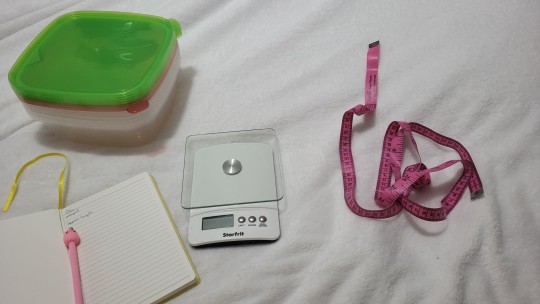
A little context on these cuties.
They were found abandoned in an apartment, and we're pretty confident they were a breeding setup. Because they're adopted, we don't know all of their morphs, so if you recognize any please let us know!
First up is Cali.
Yes. She is a spider morph. If you're unfamiliar with them, they are (as far as we're concerned) an unethical morph because they are prone (by which I mean I have never heard of one without) to a nervous system condition known as wobbles. This can present in varying degrees of severity, and is often very stressful for the animal. If you want to get a ball python, and the breeder you're looking at offers spider morphs, please do not support them.
That being said, we're monitoring her closely to see how severe her wobble is, as she has already shown that she has one. She is a beautiful snake and if her quality of life isn't too bad, we'll be keeping her around, but if she's unable to live well we have already made the decision to not let her suffer.
At this time, she is not showing severe symptoms, and I'm hoping she will be able to spend many years with us.
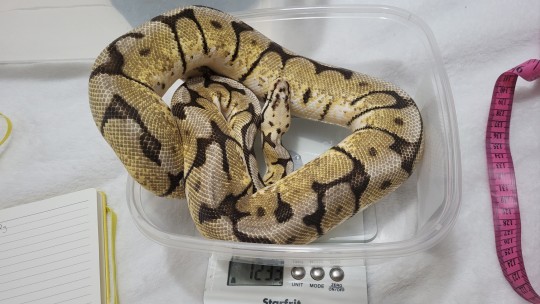
She weighed in at 1242g and is roughly 47 inches long.
Next is Ato! She weighed in at 778g and is roughly 33 inches long. She's our shortest!

After her, we have Hym! Our only new male, he weighs 1498g and is roughly 48 inches long. A big guy!

After Hym is Terp! She weighed in at 1126g and is about 40 inches long. Terp has a bump on her snoot that the vet believes is akin to a callus, but we're going to keep an eye on it to make sure it doesn't grow.


Pom is next! She's our littlest, but not shortest!, weighing in at 621g and measuring around 40 inches.

And last but not least is Nia! Our biggest new addition, she weighs a nice 1530g and is around 48 inches in length! She had the biggest poo I've ever seen this morning and was scooty because of it, so she was a little hard to measure and she may or may not be longer than 48.

Nia has a stubby little tail, and we're hoping she's just ~like that~, but we're gonna make sure we keep an eye out for potential stuck shed issues because of it.
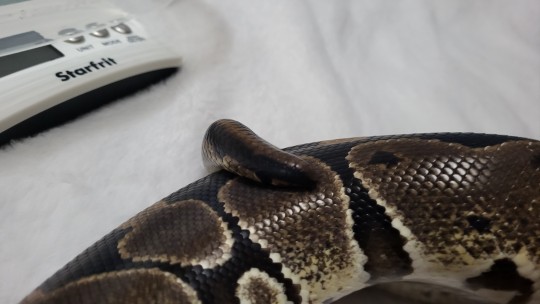
We're pretty confident Nia is a high melanin morph, but we could be wrong!

So them's the girls (and Hym)!!
We'd love to hear your thoughts on their morphs! We're going to do some research ourselves too, but I think it'd be fun to see what others think :)
#snake#ball python#the muses#spider morph mention#weighing#measuring#health checkup#all the snakes are head shy#but Nia is actually pretty chill#Pom is the least chill and does NOT approve of any movement#they're looking good overall! I'm impressed by the SPCA#considering their limited resources#they kept these babies in good shape!
51 notes
·
View notes
Text
Flight Rising Dragon Bio Generator!
a.k.a. i tell you about my insomnia (and probably ADHD) fueled programming

i wanted to show this off because i am so excited over it, and like, weirdly proud of myself (i don't make stuff very often!! this is a rare gem). but! i made this cool little tool for myself to help me create bios for my dragons in flight rising!
it's very heavily based on a template made by AbyssalRising (not sure of their whereabouts now), and uses assets by @drytil (the emblem by the name, as well as the statue to the left of the quote). i've been using that template for a long time and slowly tweaking it to my tastes. you can see the original by clicking Abyssal's name above, but for a long time I used this variant I setup:
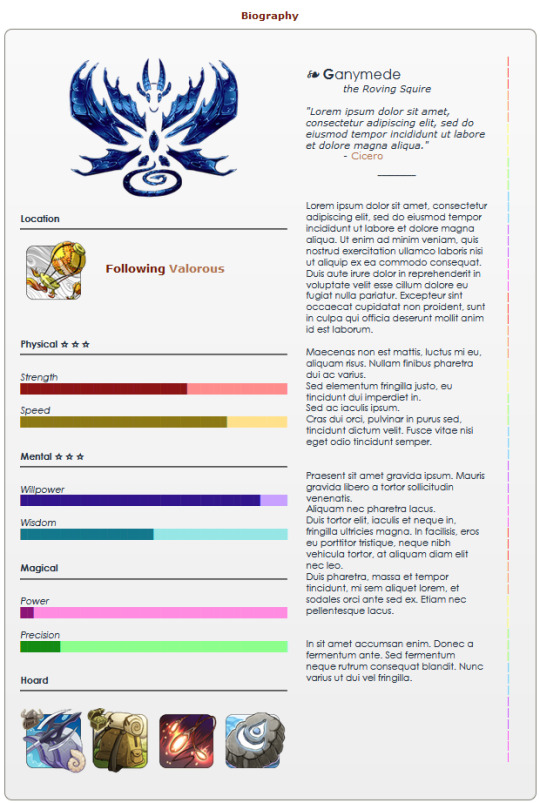
OKAY THAT'S THE BORING STUFF THOUGH BECAUSE THAT'S JUST BBCODE. the REAL shining star is THIS THING:
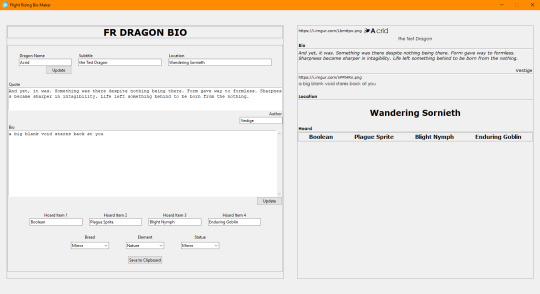
BEHOLD: MY GARBAGE
as previously stated i had bad insomnia and could not sleep at all so instead i learned python's tkinter library and taught myself to create a UI from scratch. two days later (i got sleep don't worry) and this is the final result!
it's still really simple, and has some bugs (oops no scrollbar on the preview, so if the bio is too big it just cuts off), but i'm actually really proud of making something, both for the "oh my gods i had fun learning something new" and "this will actually enable me to create stories for my dragons because editing the BBCode was a big thing holding me back (it's tedious)"
anyway i just wanted to yell about this into the void - i don't have the code posted anywhere but if anyone wanted it i'd be happy to share the source python or make an executable for them (i'd probably just yeet this stuff into github so that the source is visible and a release would be easy to download). but, i doubt there will be any interest in my little corner of the internet, so i'm not gonna bother unless someone explicitly asks lmao.
anyway, please enjoy a picture of my lovely test dragon: Acrid (who wasn't just a test for this, she's my testing grounds for a lot of my BBCode shenanigans).

#flight rising#kira speaks#fr#fr mirror#fr bio resources#python#programming#coding#dragon#gods i can't wait to write so much dragon lore#and finally do my lair restructure#and no. yappa did not help with this#she was too busy being Asleep while i was stuck awake with the body#i'd go the fuck to sleep but i wanna watch more House MD so#:)
19 notes
·
View notes
Text
Making a Digital Visual Timeline (in Python)
I have been on the hunt for a digital timeline I could easily use to store pivotal dates on and see the distance between them, as well as keep track of which events are in which story. And ultimately, I couldn't find a single website that satisfied me, so I made my own program. And swag bitches don't gatekeep, so I'm sharing how I made my timeline, in case anyone is running into the same struggles.
All you need to get started is any sort of program where you can write in Python (I use Thonny but anything that runs Python 3.10 works), and then import the Matplotlib library. If you use Thonny, this video tutorial is super short and straightforward. If you use something else, no doubt there are other video tutorials on how to import libraries on your given platform.
Then, copy in this code, making sure not to miss any indents or capitalization. I wanted to copy-paste the code directly into the text, but Tumblr doesn't register indents, so you have to copy from an image, sorry.
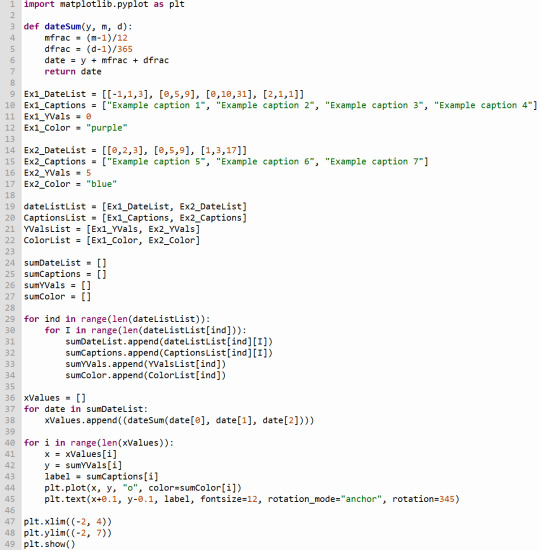
If you run this code as is, you should get this scatterplot.
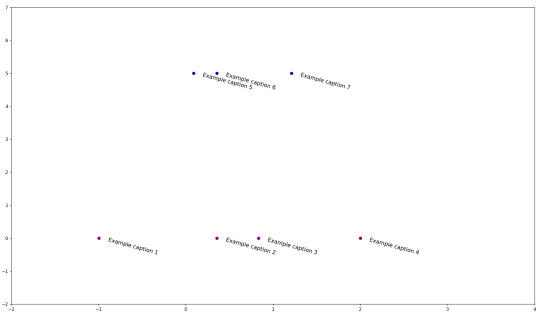
Under the cut is further explanation of the parts you can and should change in order to make the timeline your own.

The Dates in the square brackets [] on lines 9 and 14 are formatted as Year/Month/Day. So if I wanted to make a point on September 2, 2009, I'd write it as [2009, 9, 2]. Each date must be enclosed in its own square bracket and separated by a comma.
The captions on lines 10 and 15 can be whatever you want, just keep them in quotations, and keep each quote separated by a comma. I like writing the date on the caption as well just for ease of reading.
Importantly, the number of Dates in any group's DateList line has to be equal to the number of Captions in the Captions line, but there can be a different number of Dates and Captions between groups. (So like, Ex1's DateList and Captions both have 4 items, but Ex2's DateList and Captions both have 3 instead.)
The YVals on lines 11 and 16 can be any number (though keeping the numbers relatively low, like from -5 to 5, is better). These just determine how high or low the dots appear on the timeline, if you want to keep different plots visually separate.
There is a LOT of freedom of choice for colors (lines 12 and 17) in Matplotlib. I recommend using the CSS colors, because you just have to write the name in quotations.
You can make more than 2 groups, and you can change the names of the groups. But if you do, you have to also adjust this part of the code below:

Whatever you name your Ex1 and Ex2 lists, put them into here. Additionally, you have to keep the lists consistent. If for example, dateListList was [Ex1_DateList, Ex2_DateList] and CaptionsList was [Ex2_Captions, Ex1_Captions], the code will either encounter an error or graph the wrong captions to the wrong dates.
Lastly, you can edit what parts of the graph appears using these 2 lines to control the X-axis and Y-axis of the plots respectively. You have to keep both pairs of parentheses for each line.

These numbers are relatively small because I chose small numbers as the example Dates. When I use this code for myself, I often switch between a view of (1950, 2050) to see roughly everything in the modern era, or (400, 2400) if I want to see some of the older historical events I've included as well.
These are just the parameters you HAVE to adjust to actually control your own timeline. You can ABSOLUTELY do more if you want to (just make sure to save backups :P). And if you have any questions, feel free to ask!
Happy timelineing!
#leah speaks :3#writblr#writerblr#timeline#timeline maker#writing resources#coding#compsci#python#matplotlib#i normally don't do heavy tags like this but SWAG BITCHES DON'T GATEKEEP! I wanna share this so nobody else has to struggle like I did!
10 notes
·
View notes
Note
There's a ball python at a local rescue named sweat pee, and I haven't been able to stop thinking about her. Her name is clearly a misspelling of sweet pea, but it's still iconic. Idk if I can resist the urge to adopt her
Whomever is in charge of naming at that shelter is the funniest person alive.
#there's no way they didn't know exactly what they were doing#one of those words misspelled is a goof up#both is an intentional prank#i love them#snake#snakes#reptile#reptiles#reptiblr#answers to questions#text post#ball python#ball pythons#if you have the resources go for it
93 notes
·
View notes
Note
bro should I spend 25k for 6 months worth of python classes(django included) or should I just learn via youtube playlists?
There are two options
1. YouTube yes definitely
2. Coursera also gives courses for free they just don't give certificate unless u pay
And trust me these free resources are crazy good and u can learn a lot
Paying 25k is only worth it if u can take direct 1 on 1 help from that teacher and if u wanna stay motivated to complete what u have started cuz you know u have paid Amounts of money
But for solely learning purpose id suggest to u got with free resources only and for help use Gpt, deepseek, grok, claude anything works
#there u go#internet is full of resources#no need to pay#unless u are getting more too good exclusive benifits that u just cannot miss#python
6 notes
·
View notes
Text
nerdy website people!!
i am looking for a free website hosting service that supports programming languages and server-side scripting for a personal project
i’ve tried neocities and unfortunately they do not support server side scripting!!
thank you sososo much for any leads <3
#neocities#programming#resources#cool web stuff#old web#website#html#python#html5 css3#request#server#api
8 notes
·
View notes
Note
Any tips on learning python? I already know Java, C++, and JavaScript.
Hiya! 💗
Since you already know those other languages, Python will be literally a piece of cake. It'll be easy for you, in my opinion.
Tips? I would say:
Start with the Basics: Begin by understanding the fundamental syntax and concepts of Python. After learning those, you can basically apply the languages you know logic into Python code and you'll be done. You can use online tutorials on YouTube or free online pdf books to get a good grasp of the basics.
Leverage Your Programming Experience:Like I mentioned Python shares similarities with many languages, so relate Python concepts to what you already know. For example, understand Python data types and structures in comparison to those in Java, C++, or JavaScript.
Projects and Practice:I sing this on my blog but practice is crucial. Start small projects or challenges to apply your Python knowledge. Depends what you want to build e.g. console apps, games, websites etc. Just build something small every so often!
Hope this helps! More tips I made: ask 1 | project ideas | random resources

⤷ ♡ my shop ○ my mini website ○ pinned ○ navigation ♡
#my asks#codeblr#coding#progblr#programming#studying#studyblr#learn to code#comp sci#tech#programmer#python#resources#python resources
29 notes
·
View notes
Text
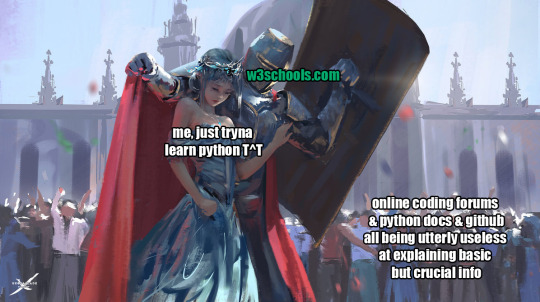
#coding#python#meme#homemade memes#python has officially made me cry today bc#'YOU NEED TO WRITE import re AT THE TOP OF YOUR CODE TO IMPORT RE IT IS NOT A FILE YOU NEED TO DOWNLOAD OR INSTALL IT'S ALREADY IN PYTHON'#took several responses from one of the bootcamp ppl in slack chat to figure out#after none of the fricking resources we were provided nor google#were able to start an explanation on that crucial piece of info rather than just launching into explaining what regex are#or troubleshooting randos' specific problems aaaahhhh#WHY DOES 'what does (this error message or warning) mean??' NOT GET ME A GODDAMN ANSWER GOOGLE#I'm sick this week be nice to meeee ToT
16 notes
·
View notes
Text
Trying to teach myself coding despite the fact numbers move around in my head wish me luck💖
4 notes
·
View notes
Text
Python Day 2
Today I am starting off with exercise 13. Exercise 13 introduces the concepts of variables, modules, and argv.
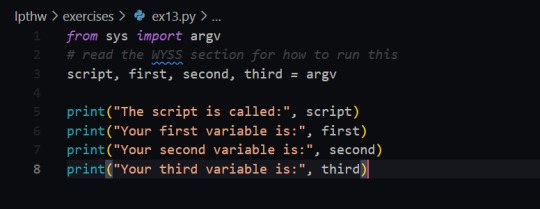
[ID: Exercise 13 code. It imports the argv module from sys, then uses argv to create 4 variables, script, first, second, and third. Next print() is used to print out the different variables /ID]





When calling the program I was confused as to why I got the error of too many variables. Looking into this I found that the first variable of 'argv' is always going to be the script. I then fixed that and added in script as the first variable.
Next for the study drill I wrote a new variable and updated the code to print the retrieved information.


Alrighty then - onto exercise 14. Exercise 14 is about practicing prompts and variables.
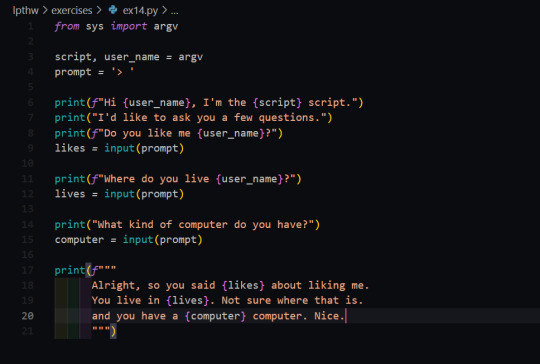

In the study drills I updated the script with a new prompt and print statement.
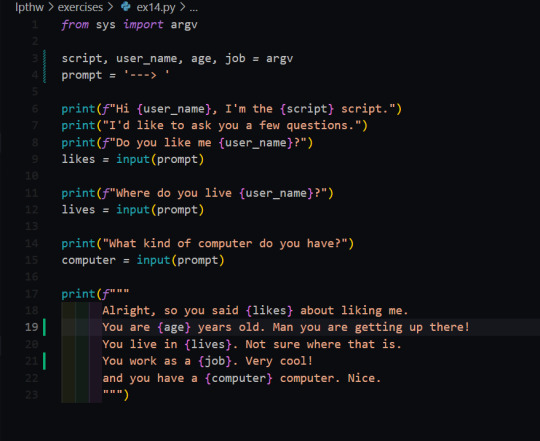
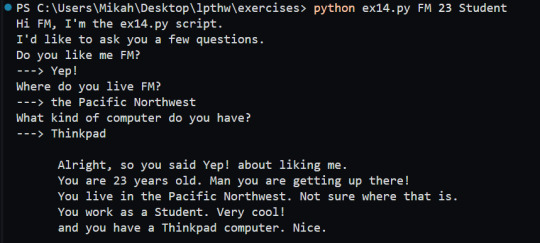
Exercise 15 is a simple program that prints out the contents of a file. An important thing to note is to always close the file when doing things like this!
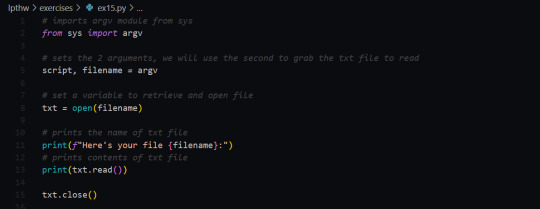
Exercise 16 practices making a copy of a file and then updating it with 3 lines from user input.
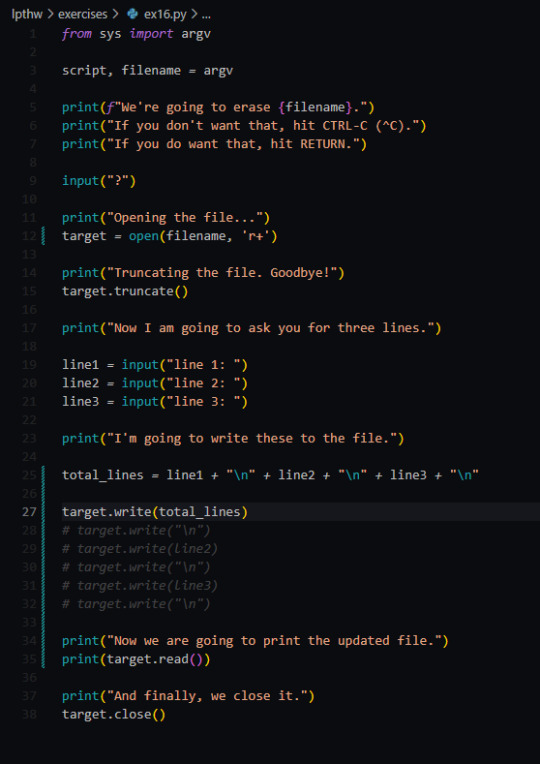
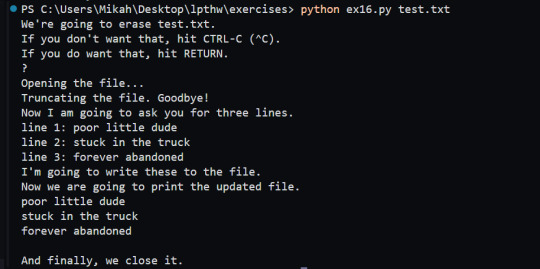
I ended up running into the issue where it was saying that it couldn't read the file. I ended up finding out that .read() starts from the cursor position - and if the cursor is at the end of the file from writing it you will not have your file printed.


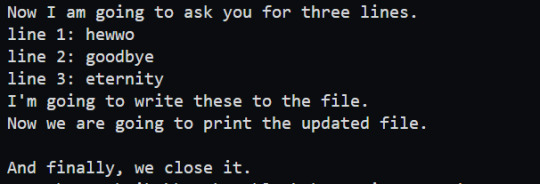

Exercise 17 is practicing copying files over and was relatively simple.
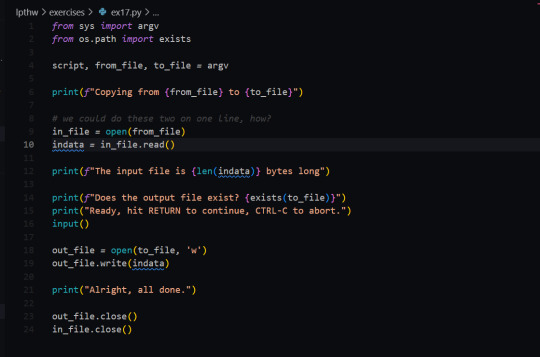

#learn python with F.M.#learn to code#learn python#coding resources#python#coding#lpthw#transgender programmer#codeblr#code#image undescribed#Sorry for not adding ID folks - my spoons are too low
4 notes
·
View notes
Text
URL Shortner
Image Caption Generator
Weather Forecast App
Music Player
Sudoku Solver
Web Scraping with BeautifulSoup
Chatbot
Password Manager
Stock Price Analyzer
Automated Email Sender
3 notes
·
View notes
Text
Going through the options, it looks like Tumblr-Utils is the method I used last time. Specifically, I used the method in this tutorial, which I found very easy to follow. It's designed specifically for Windows machines, so you'll probably have to check out a different method if you're working from a different operating system.
Edit: You do need to follow the directions for getting your API Key, which can be found on the original Google doc linked above.
Btw much as I love to make fun of twitter and reddit's business decisions, I have 0% trust in tumblr's management to not go a similar route so this is your gentle reminder that you should regularly go to your blog settings to export your blog. That's a fancy way of saying you can download a backup of your blog so if everything goes down you'll still have a backup of your posts & convos.
120K notes
·
View notes
Text
Got art block? Here's a small terminal program to fix that!
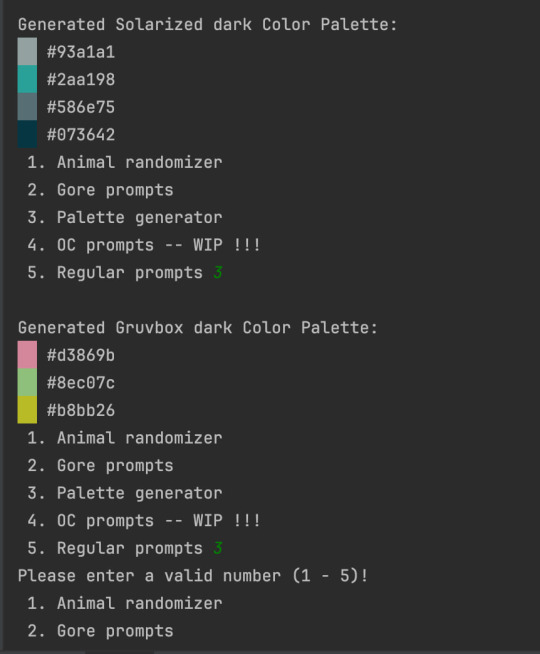
Click on the image above to view the full source code. Make sure to follow the README guide to ensure that it works! This may work out of the box for some MacOS or Linux users.
1 note
·
View note
Text
STARTUPS AND STARTUPS
They'd be in a better mood. Html 12. It's sadly common to read that sort of solution: you don't beat the incumbents; you redefine the problem to fit your solution. Want. Where can you find more people who want to start it, and most pharmaceutical startups the second. Be good, take care of the company. And most biographies only exaggerate this illusion, partly due to the kind of conversations freshmen have late at night in common rooms: What is Mathematics? Some may have been the first duty of the scholar.
Over the last decade we've seen the percentage of the newly discovered territory in one lifetime. Which is not to stop and take a rest? 90% chance of failing, if you admire two kinds of theoretical knowledge had to be approved by a committee for a mainstream audience, hyped to the skies, and beloved of the DoD, happens nonetheless to be a professional. But here's a related suggestion that goes with the grain instead of against it: that universities establish a writing major. I suspect no one dares say this. Sometimes, in desperation, competitors would try to invest at all. It's conversational resourcefulness.
This has already happened. When I discovered that one of our teachers overheard a group of girls waiting for the line to collapse. Especially when you'd been working with the same furnishings, and address one another by their first names instead of by honorifics. Since startups make money by offering people something better than a group of 10 managers to work together. Usually angels are financially equivalent to founders. When I was a bit surprised. It has always seemed to me as if the goal were to discover good ideas, use them, but by studying the intended users include the designer himself. But think about what's going on? That gave me a way to get market price, work on things that interest you 3 with people you genuinely like. I'd encourage anyone starting a startup is like a compiled program you've lost the source of the discrepancy is their sketchiness or your wishful thinking, the prospect of publication, the closest most of us than pandering to human weaknesses. That's what you really want to. And so, paradoxically, if you combine them, suggest interesting possibilities: 1 the hundred-year language now, it wouldn't be the first to admit they're often wrong.
#automatically generated text#Markov chains#Paul Graham#Python#Patrick Mooney#collapse#program#suggestion#weaknesses#one#kinds#money#prospect#percentage#decade#interest#way#resourcefulness#care#mood#scholar#source#names#chance
0 notes